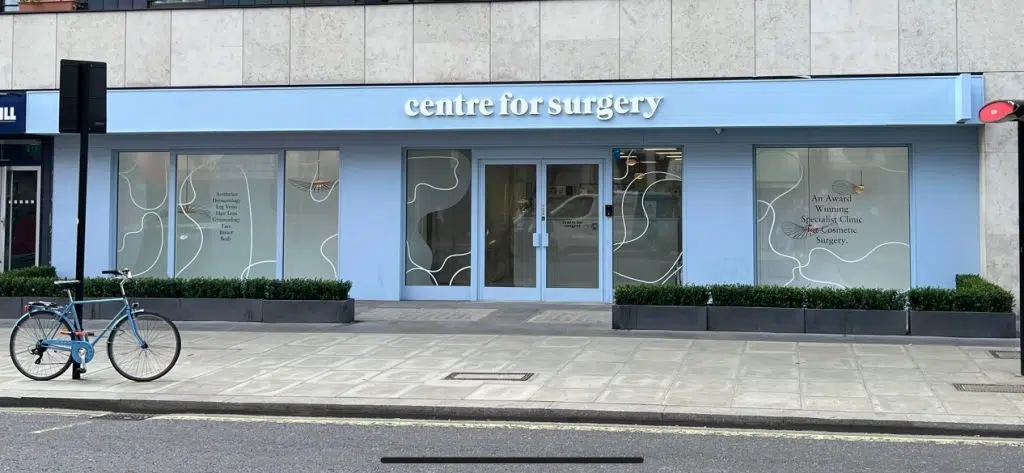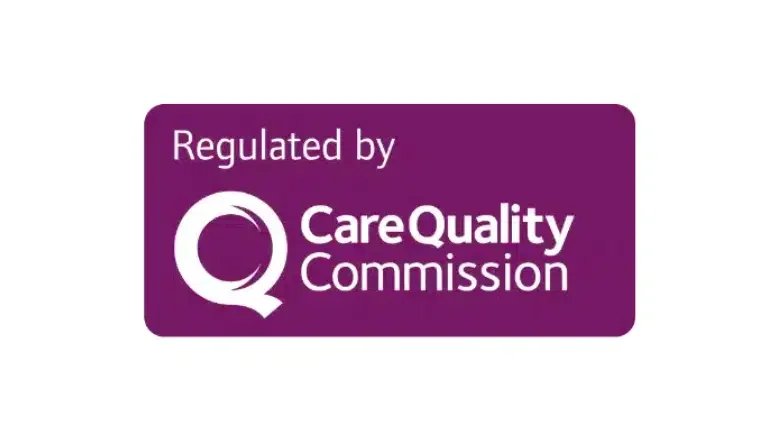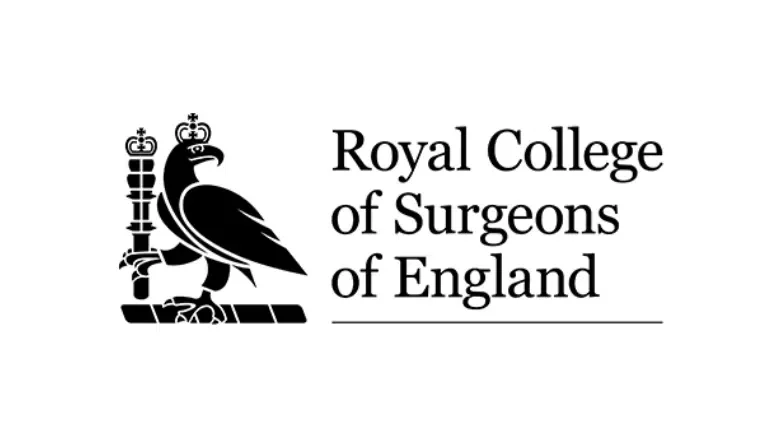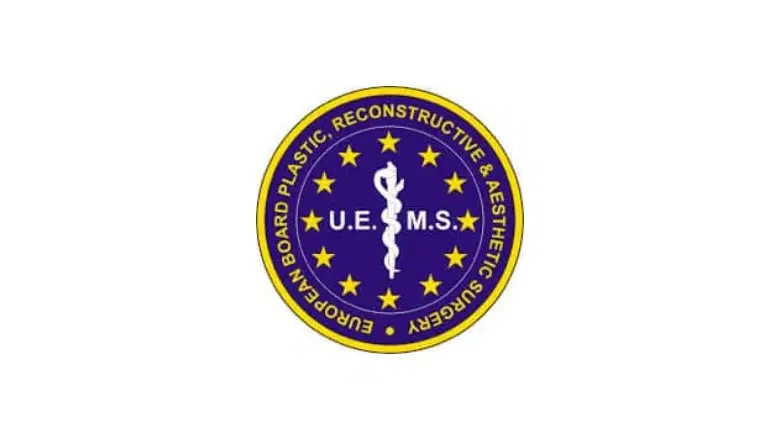THIGH LIFT SURGERY LONDON, UK
Transform your silhouette with a thigh lift – our experienced surgeons skillfully remove excess skin and fat to reveal sleek, contoured thighs, boosting your self-esteem and body confidence.
Significant weight loss is a commendable achievement and a testament to an individual’s commitment to a healthier lifestyle. However, it often leaves behind a reminder in the form of excess, saggy skin distributed throughout the body. This saggy skin isn’t just a cosmetic issue; it can also pose physical challenges, potentially hindering your ability to fully embrace and enjoy your newly slimmed-down figure.
One area particularly affected is the thighs. Excess skin in this region can cause discomfort, restrict movement, and prevent you from wearing clothes you would like. Unfortunately, there are no non-surgical treatments currently available that can effectively address this issue.
The solution lies in an Upper Thigh Lift procedure. This surgical intervention is designed to remove the excess skin from the thigh area, resulting in a smoother, firmer, and more contoured appearance. It’s a proven method to reclaim your body and boost your self-confidence.
RELATED: Thigh Lift FAQs – Q&As about Thigh Reduction Surgery
At Centre for Surgery, we specialise in post-weight loss surgical procedures. Located in London, we pride ourselves on housing some of the most esteemed Specialist Plastic Surgeons across the UK. Our surgeons are well-versed in the intricacies of body contouring surgeries like the upper thigh lift, and they are committed to delivering transformative results in the safest, most effective way possible. With us, you can trust that you’re in capable hands.
WHAT IS A THIGH LIFT?
A thigh lift procedure, also known as thighplasty, is a form of cosmetic surgery specifically designed to address the issue of excess, saggy skin in the thigh region. This condition is often a result of substantial weight loss. The primary goal of the procedure is to excise droopy skin and unnecessary fat tissue, thereby enhancing the natural contours of the thigh.
Following a thigh lift procedure, patients can expect firmer, smoother thighs with a more naturally curved appearance. The surgical scars are typically well-concealed within the body’s natural folds, making them less noticeable over time.
In many instances, the thigh lift procedure is performed in conjunction with liposuction. Liposuction aids in the removal of stubborn fat deposits that might be difficult to eliminate solely through a surgical incision. These two procedures, when executed together, can provide superior results, offering a comprehensive solution to reshape and refine the contour of the thigh region.
A thigh lift procedure, particularly when combined with liposuction, has the potential to significantly improve the aesthetics of the thighs, resulting in increased comfort, improved confidence, and a broader choice of clothing options.
THIGH LIFT PHOTO GALLERY
At Centre for Surgery, we are proud of the high satisfaction rates among our thigh lift patients. Thigh lift surgery often leads to toned, youthful, and naturally contoured thighs. The benefits of this surgery are generally immediate and long-lasting, particularly if patients maintain a healthy weight post-surgery.
The surgical scars resulting from a thigh lift are usually not visible unless the legs are crossed while seated, and these scars should fade gradually over time.
As with any plastic surgery, the procedure may have varying impacts on your friends and family. Some individuals might not notice a significant difference, while others may respond negatively. If you encounter such reactions, it’s crucial to remember your objectives when deciding to undergo surgery. Bear in mind that you chose this path for your own satisfaction and well-being, not to cater to the opinions of others.
During your comprehensive consultation, your plastic surgeon will present a variety of photographs illustrating the outcomes of previous thigh lift patients at the Centre for Surgery. This will give you a realistic expectation of the results you can anticipate. You are also encouraged to visit our online thigh lift photo gallery to view a selection of successful surgeries performed at our centre.
Case 1:
Bilateral inner thigh lift
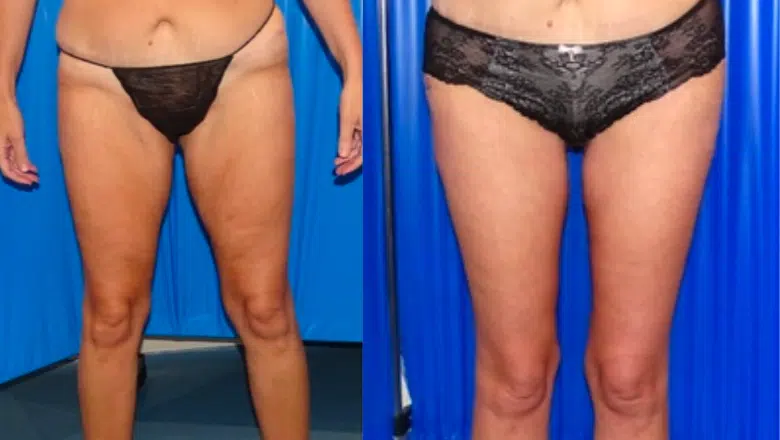
Case 2:
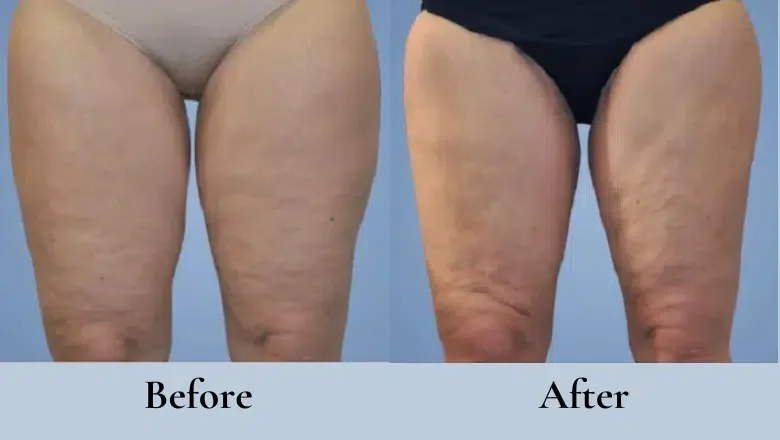
Case 3:
Bilateral inner thigh lift after massive weight loss using vertical scar technique and liposuction
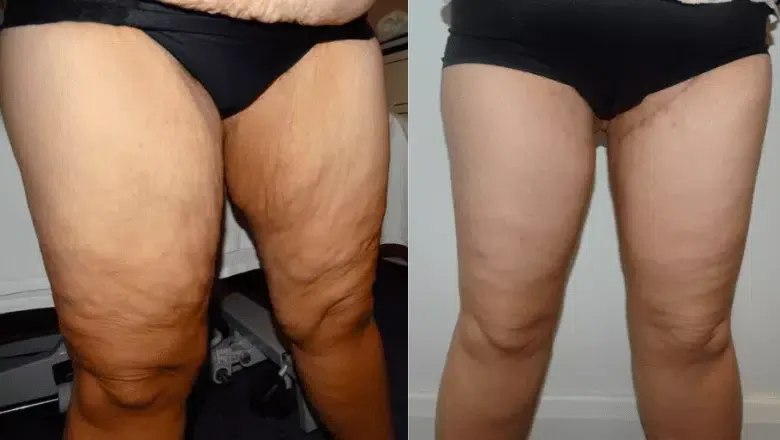
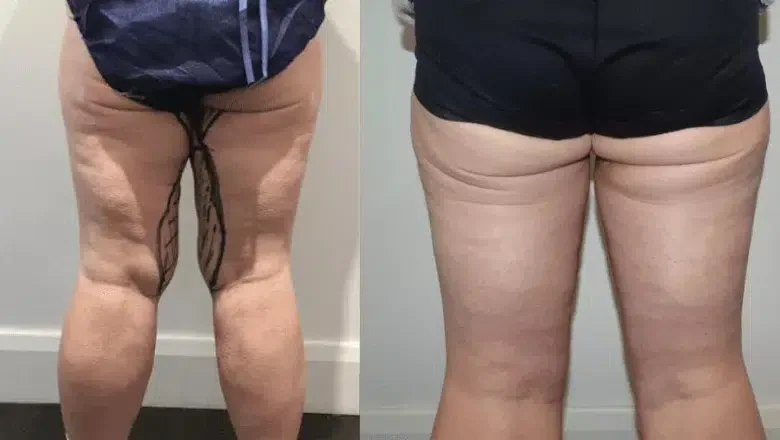
Case 4:
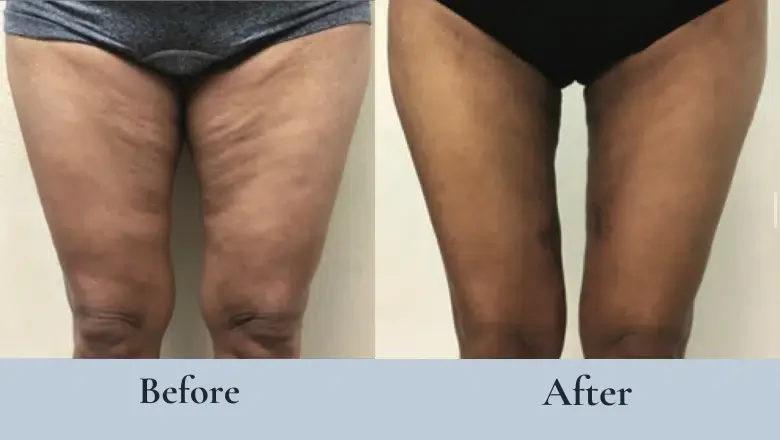
Case 5:
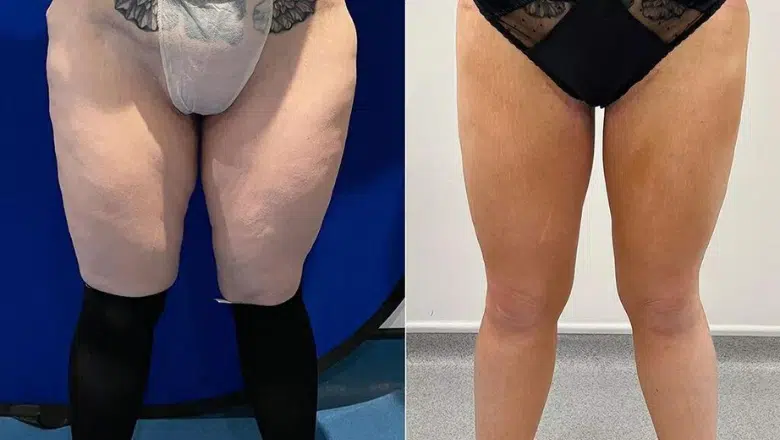
Case 6:
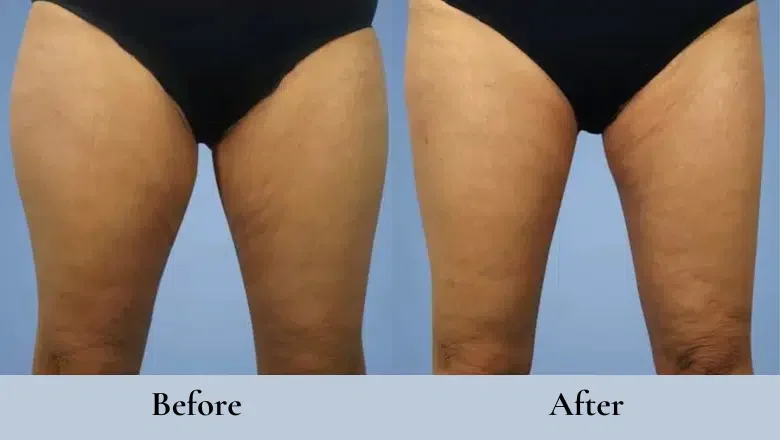
BENEFITS OF A THIGH LIFT
The thigh lift procedure is a cosmetic surgery offering numerous benefits, both aesthetically and functionally, impacting positively on your physical well-being, mental health, and overall body contour.
Improved Physical Health
Excess, saggy skin often results in skin folds which are prone to irritation and rashes due to constant rubbing. These folds can also foster bacterial growth, increasing the risk of skin infections. A thigh lift procedure can effectively mitigate these issues by removing the excess skin.
Enhanced Body Aesthetics
Having excess skin around your thighs can make finding well-fitting clothes a challenging task, potentially causing emotional distress and impacting self-esteem. By undergoing a thigh lift, you can eliminate this excess skin, resulting in firmer, more contoured thighs. This reshaping can significantly boost your confidence and improve your body image.
Freedom in Clothing Choices
After the procedure, you’ll enjoy the freedom to show off your legs in any outfit without the concern of saggy skin. The surgical scars are generally hidden within the natural folds of the leg and typically fade over time, making them less noticeable.
Positive Social and Interpersonal Impact
Increased self-confidence and body satisfaction following a thigh lift can positively influence social interactions and interpersonal relationships. Feeling good about your body can radiate positivity and confidence, enhancing all areas of your life.
IDEAL CANDIDATES FOR A THIGH LIFT
Candidates considered ideal for a thigh lift procedure are those who meet certain eligibility criteria, which are defined to ensure the health and safety of the patient, both before and after the procedure. The surgeons at the Centre for Surgery meticulously evaluate each patient against these criteria to minimise the risk of severe post-operative complications.
The optimal candidate for a thigh lift procedure:
Is in good physical and mental health
An individual’s overall health status significantly impacts the surgery’s success and the healing process. Therefore, candidates should be free from severe health conditions that could interfere with surgery or recovery.
Has a substantial amount of excess saggy skin in the thigh region
The primary purpose of the procedure is to remove this excess skin, making this a crucial criterion.
Is at or near their ideal body weight
Candidates should have a stable weight and a healthy plan in place to maintain it. Major fluctuations in weight after the procedure could compromise the results.
Has no plans for significant weight gain or loss in the future:
Dramatic weight changes can negatively affect the results of the procedure and potentially necessitate additional surgeries.
Is a non-smoker or willing to cease smoking at least six weeks before and after the procedure
Smoking can interfere with the body’s healing process and increase the risk of complications.
Is electing to undergo the procedure for personal reasons, not due to societal pressure or trends
The decision to have surgery must come from a place of self-improvement and not external influences.
Is fully informed about the potential risks and complications associated with the procedure
Understanding the possible outcomes and complications ensures that the decision to proceed with surgery is well-informed.
Meeting these eligibility criteria is vital for ensuring your safety and maximising the likelihood of achieving desirable results from your thigh lift surgery.
PREPARING FOR A THIGH LIFT
Centre for Surgery takes pride in having assisted a significant number of thigh lift patients across London and the UK in regaining their confidence to wear shorts, skirts, and bathing suits comfortably, fully embracing and showcasing their thighs.
We understand that the prospect of any surgical procedure can instil feelings of nervousness or apprehension in patients. To alleviate these concerns, our team of highly skilled surgeons devote time to comprehending each patient’s desires and expectations meticulously. They provide expert guidance regarding the potential outcomes of the surgery, clarifying what can realistically be achieved and what cannot. This comprehensive approach ensures the patient is fully aware of the potential benefits and risks associated with the procedure, thereby helping them feel secure and comfortable about their decision.
The consultation process involves a detailed physical examination and review of your medical history. It also includes an in-depth conversation about your surgical goals and aspirations. You will be encouraged to communicate your ideal aesthetic look.
Our surgeons will invest ample time in ensuring that both you and they have a thorough understanding of your desired outcomes. It is important to remember that while surgery can bring about substantial change, there may be limitations to what can be achieved. Hence, having a clear understanding of realistic outcomes is crucial.
The surgeon will perform a meticulous examination to ascertain the precise procedure or combination of procedures that will best serve your goals. In the context of a thigh lift, discussions will include the location of the incision and the potential need for liposuction. Collaboratively, you and your surgeon will finalise the procedure that best aligns with your aspirations, paving the way towards achieving your desired aesthetic results.
Preparing for Thigh Lift Surgery
As part of the preparation for your thigh lift surgery, your surgeon will provide you with a comprehensive set of instructions designed to ensure optimal surgical results. These guidelines will cover aspects like diet, hydration, and the intake of specific vitamins and medications.
If you are a smoker, it is crucial to cease smoking at least four weeks prior to the surgery and continue to abstain during the recovery period. This is because smoking can hinder proper healing by decreasing circulation, thereby potentially affecting the surgery’s outcome.
In addition, certain substances can increase bleeding during the procedure, so you may be advised to avoid aspirin, anti-inflammatory drugs, or specific herbal supplements in the weeks leading up to and following the surgery. Following these recommendations is critical in ensuring your safety during the surgery and enhancing the healing process post-operatively.
THIGH LIFT TECHNIQUES
Inner (Medial) Thigh Lift
This is one of the most common types of thigh lift surgeries. It targets the inner thigh area, which can be difficult to tone even with targeted exercises. In an inner thigh lift, the surgeon makes an incision where the thigh meets the pubic area. Through this incision, they can remove excess skin and fat to achieve a tighter and more toned appearance. The scar is usually well-hidden in the natural folds of the body.
Outer (Lateral) Thigh Lift
This procedure focuses on the front and outer areas of the thigh. An incision is typically made along the line of a bikini or underwear, from the groin around the back of the body. The surgeon then lifts and tightens the skin in this area, which can help to improve the contours of the thighs and buttocks. This procedure can also help to reduce cellulite.
Inner (Medial) Thigh Lift with Liposuction
This procedure combines an inner thigh lift with liposuction to achieve more comprehensive results. The liposuction can remove larger amounts of fat, while the thigh lift tightens the skin. This procedure can be particularly beneficial for patients who have lost a significant amount of weight and have both excess fat and skin. The effects of this procedure extend further down the inner thigh than a thigh lift alone, providing a more complete transformation.
Each of these procedures can be customised to meet your specific needs and goals. During your consultation, your surgeon will discuss these options with you and help you decide which technique is best for you.
PROCEDURE
Thigh lift surgery is a day-case procedure under TIVA general anaesthesia. This means you can recover in the comfort of your own home later the same day. The procedure takes about 2-3 hours, depending on the amount of excess loose skin and whether additional liposuction needs to be performed. Thigh lift surgery uses a combination of 2 surgical methods to both reduce the size of the thigh and contour the thigh through the removal of skin. Liposuction is performed first, followed by surgical removal of excess skin.
The surgical removal or excision of excess thigh skin effectively treats the loose hanging folds of skin commonly found in the inner thigh region. The incision for a thigh lift is most commonly made on the inside of the thigh. An ellipse of redundant skin is surgically removed, followed by a small amount of liposuction to fine-tune the contouring of the area. Once the desired thigh reduction has been achieved, the surgeon will meticulously suture the thigh incisions to leave a cosmetically acceptable scar. Thigh lift surgery is a combination procedure that encompasses both the removal of excess fat deposits and the removal of redundant thigh skin to expertly contour the thigh, leaving a contoured and sculpted appearance that is firm to the touch.
Thigh lift surgery can be either a mini thigh lift or a full thigh lift. The difference is in the placement of the incisions. The surgeon may make a horizontal or vertical incision, depending on your thigh shape, the location of the excess skin and fat and your end goals. A mini thigh lift incision is located primarily in the groin fold with no extension down the thigh. A full thigh lift involves both the groin incision and the full-length incision down the thigh to address thigh skin laxity effectively. In either case, liposuction using the power-assisted technique is commonly employed to remove excess fat minimally invasively. The decision to perform liposuction will be determined by the amount of skin laxity and excess fat present. Those with better skin quality may benefit more from liposuction as their skin envelope will be able to contract down more effectively on the newly reduced thigh contour. Massive weight loss patients will benefit more from a primarily surgical skin removal technique as liposuction may worsen any significant pre-existing skin laxity. At the end of the thigh lift procedure, the surgeon will use dissolvable sutures, which eliminate the need for separate suture removal, and a sterile dressing will be applied. A specialist compression garment will be applied to reduce the amount of bruising and swelling and protect the incisions from unintended trauma.
Principles of successful thigh lift surgery
Thigh lift surgery can be a complex procedure, and it is essential to choose a highly experienced body contouring surgeon to get the best results. The success of thigh lift surgery is determined by both thigh symmetry and potential scarring after thigh reduction surgery.
Your surgeon takes preoperative planning very seriously to make sure that outcomes after the thigh lift are optimal. Obtaining a symmetrical result is a function of accurate preoperative markings and using delicate surgical techniques to minimise the risk of bleeding. Our surgeons often see patients who have had thigh lift surgery performed elsewhere and have had unsymmetrical results. Revision thigh lift surgery using fat grafting and sometimes skin grafting is required to address the asymmetry.
Thigh lift surgery results in a significant scar burden. Despite this, our surgeons carefully place incisions in natural skin folds to minimise visible scarring. Thigh lift scars take several months to mature fully. At Centre for Surgery, our specialists access the full range of scar treatments to optimise the appearance of thigh lift scars.
RECOVERY
A thigh lift, like any other surgical procedure, does require a recovery period. The length and nature of this recovery period can vary based on the extent of the surgery, the specific techniques used, and the individual patient’s overall health and healing ability.
RELATED: Recovery After Thigh Lift Surgery – Top Tips
In general, patients can expect to experience some swelling, bruising, and discomfort in the days following their thigh lift. Pain can typically be managed with over-the-counter pain relievers or prescribed medications. It’s also normal to have drains in place after the surgery to help reduce swelling and prevent fluid buildup. These are usually removed after a few days.
Patients are encouraged to start moving and walking around as soon as they feel able, as this can help reduce the risk of blood clots and promote healing. However, more strenuous activities, such as heavy lifting or vigorous exercise, should be avoided for several weeks or until your surgeon gives you the go-ahead.
Compression garments should be worn during the recovery period, as they can help reduce swelling and support the newly contoured thighs. These garments are typically worn for several weeks.
It’s crucial during recovery to maintain a healthy lifestyle – this includes eating a balanced diet, avoiding smoking and excessive alcohol, and getting plenty of rest. This not only aids in the healing process but also helps maintain the results of the surgery in the long term.
Regular follow-up visits with your surgeon will be scheduled to monitor your progress and ensure you’re healing properly. During these visits, your surgeon can also provide guidance on when you can resume normal activities and return to work.
Remember, everyone’s recovery timeline is different, and it’s important to listen to your body and not rush the healing process. It can take several months to see the final results of your thigh lift as swelling subsides and the skin and tissue settle into their new contours. Patience and proper care during this period are key to achieving the best possible outcome.
HOW TO MINIMISE SCARS
Thigh lift surgery has increased in popularity as an effective method of improving thigh contour after all degrees of weight loss, from mild to massive. Many patients are concerned about the appearance of scars after thigh lift surgery, but this has become less of a concern with modern surgical techniques. Most patients accept the trade-off between achieving a dramatically improved thigh contour at the expense of what can be a long scar along the inner thigh. Our surgeons use advanced surgical techniques to give a straighter-looking scar that is located along the inside of the thigh, and this results in a well-concealed scar that is not obviously visible to others.
Thigh lift scars vary from one patient to another, and there are a number of factors which can influence the degree of scar formation:
- Positioning of scar
- Skin colour
- History of hypertrophic or keloid scars
- Exposure of healing incisions to strong sunlight
All thigh lift incisions leave scars as a result of the procedure to remove excess skin and fat. Modern methods of scar management help to improve the appearance of scars. It is important to wear the postoperative garment as instructed by the surgeon in combination with specialised postoperative brown tape along the incisions. This protocol helps to prevent stretching of the scar and reduce the incidence of red and raised scars over time. At four weeks after surgery, your surgeon may recommend the application of silicone gel sheets once the incisions have fully healed, and this will help to optimise scar cosmesis further. It is essential to keep the thigh incisions out of direct sunlight and to use a sunscreen of SPF 30 or higher applied to the scars. You should avoid direct sunlight exposure to the treated areas for six months after surgery.
RISKS
While thigh lift surgery is generally considered safe when performed by a qualified and experienced plastic surgeon, like any surgical procedure, it carries certain potential risks and complications. It’s important to understand these potential risks before proceeding with the surgery. Here are some of the potential risks and complications associated with a thigh lift procedure:
Allergic reactions
As with any procedure that requires anaesthesia, there is a small risk of an allergic reaction to the anaesthetic used.
Bleeding
There is always a risk of bleeding with any surgical procedure. However, surgeons take great care to minimise this risk during the operation.
Seroma or fluid accumulation
This is a common complication of many types of surgery. Seromas are pockets of clear bodily fluids that can develop under the surface of the skin. They may require drainage if they don’t resolve on their own.
Persistent pain and bruising
Some level of pain and bruising is normal after surgery, but if pain persists or is severe, it could signal a problem.
Persistent numbness
It’s normal to experience some level of numbness after surgery due to nerve trauma. However, in rare cases, this numbness can become persistent.
Infection
As with any surgical procedure, there is a risk of infection. Surgeons take several precautions to minimise this risk.
Asymmetry
While surgeons aim for symmetry, the human body is naturally asymmetrical, and there may be minor differences in the appearance of each thigh after surgery.
Damage to surrounding structures
While rare, there is potential injury to surrounding tissues, nerves, or muscles during surgery.
Fat necrosis
Fat cells die in this condition, resulting in firm lumps. This is relatively rare but can occur.
COSTS - PRICES & FEES
The cost of a thigh lift in London, UK can vary greatly depending on a number of factors. The exact price of the surgery will depend on the complexity of the procedure, the amount of time required in the operating room, and the surgeon’s experience and expertise. Additional costs such as anaesthesia, hospital fees, and post-operative care can also influence the total cost.
During your initial consultation at Centre for Surgery, our surgeon will assess your specific needs and provide you with a detailed quote. This quote will include all costs associated with the procedure, including the surgeon’s fee, anaesthetist fee, hospital fees, and any aftercare or support required.
In regard to insurance coverage, it’s important to remember that most cosmetic procedures are not covered by private health insurance. However, in certain cases where the procedure is deemed medically necessary, some of the costs may be covered. For instance, if the excess skin and fat on your thighs are causing significant health issues such as persistent skin rashes, or negatively affecting your quality of life, your insurer may cover a portion of the costs. Another condition that could potentially lead to coverage is if your weight has been stable for at least six months prior to the procedure.
However, insurance policies vary greatly, and it’s important to check with your specific provider to understand what is and isn’t covered. Your surgeon and our administrative team at Centre for Surgery can provide guidance and assist you in understanding your insurance coverage. It’s important to have these discussions early on in your surgical journey to avoid any unexpected costs.
WHY CHOOSE US?
What is included in my thigh reduction treatment package?
- As many preoperative consultations with your surgeon as you like to make sure the procedure is right for you
- Treatment at a specialist day surgery facility was recently rated ‘Good’ by the CQC.
- Enhanced same-day discharge with the added benefits of recovering in your own home
- 24/7 clinical support from your surgeon for the first 48 hours and our expert postoperative support team
- Your very own dedicated patient coordinator
- In-depth preoperative medical assessment to make sure you are fully fit for the brachioplasty procedure
- Exceptionally high standards of postoperative care described as ‘outstanding’ by the CQC with regular telephone and face-to-face checks by our expert postoperative support team.
RealSelf Top Doctors for thigh lift
RealSelf’s top doctor status is awarded to less than 10% of the RealSelf doctor community. This status is earned by achieving consistently high patient satisfaction (from RealSelf reviews), getting excellent feedback on expert answers to patient questions, and investing significant time in Q&A and other doctor activities. RealSelf’s top doctors are rated among the very best surgeons in the United Kingdom.
FAQs
-
What types of thigh lifts are available?There are several types of thigh lifts that can be performed, depending on the specific concerns and goals of the patient. These include:
Medial Thigh Lift: This procedure targets the inner thighs, removing excess skin and fat and tightening the area.
Upper Inner Thigh Lift: Focusing on the upper portion of the inner thighs, this procedure addresses sagging skin and improves thigh contour.
Mini Thigh Lift: A less invasive option, the mini thigh lift targets a smaller area of the thigh, typically the upper inner thigh, and is suitable for patients with mild sagging or excess skin.
Vertical Thigh Lift: In this procedure, an incision is made along the inner thigh vertically, allowing for more extensive removal of excess skin and fat.
Posterior Thigh Lift: This procedure addresses sagging skin and excess fat on the back of the thighs, improving the overall appearance and contour.
Spiral Thigh Lift: Combining elements of the medial and posterior thigh lifts, this procedure addresses sagging skin and excess fat on both the inner and back of the thighs. -
Can a thigh lift tighten loose skin on the inner thighs?Yes, a thigh lift is designed to tighten loose and saggy skin on the inner thighs. It involves removing excess skin and tissue, and the remaining skin is then repositioned and tightened to achieve a more toned and contoured appearance.
-
How can I get rid of loose skin on my thighs?To effectively get rid of loose skin on the thighs, a thigh lift surgery is often the most suitable option. The procedure involves removing the excess skin and tissue, resulting in tighter and more toned thighs. It is important to consult with a qualified plastic surgeon who can assess your specific concerns and recommend the most appropriate treatment plan.
-
How much excess skin can be removed with a thigh lift?The amount of excess skin that can be removed during a thigh lift surgery varies depending on each individual's unique case. The goal of the procedure is to achieve a more contoured and proportionate appearance. The trade-off for skin removal is the resulting thigh lift scar, which is typically placed in a way that can be semi-hidden within the natural creases of the thighs and tends to fade over time.
-
Do I need a thigh lift or liposuction?The need for a thigh lift or liposuction depends on your specific concerns and goals. Liposuction is typically recommended for individuals with excess fat and minimal skin laxity in the thigh area. It targets and removes stubborn fat deposits. However, if you have significant sagging or loose skin on the thighs, a thigh lift is often the more appropriate choice. In some cases, both procedures may be combined to achieve optimal results.
-
Can liposuction be performed on the inner thighs?Yes, liposuction can be performed on both the outer and inner thighs to remove excess fat. It is a popular procedure for contouring the thighs and achieving a more sculpted appearance. However, it is important to note that liposuction does not address loose skin. If excess skin is a concern, a thigh lift may be necessary to achieve the desired results.
-
How do I know if I need a thigh lift, liposuction, or both?Determining whether you need a thigh lift, liposuction, or both depends on your specific anatomical characteristics and aesthetic goals. Liposuction is suitable for individuals who have excess fat deposits and minimal skin laxity. On the other hand, a thigh lift is recommended for those with sagging or loose skin on the thighs. In some cases, a combination of both procedures may be necessary to achieve the desired outcome. Consulting with a qualified plastic surgeon is crucial in order to assess your unique situation and recommend the most appropriate treatment plan. During a consultation, your surgeon will evaluate your concerns, examine your thigh area, and discuss your goals to determine the best approach for achieving the desired results.
-
Will a thigh lift get rid of cellulite?A thigh lift primarily focuses on removing excess skin and improving the contour of the thighs. While the procedure can temporarily improve the appearance of cellulite, it is not specifically designed to treat cellulite. Cellulite is caused by the structural changes in the underlying fat and connective tissue and may require additional treatments specifically targeted at cellulite reduction.
-
How can I address cellulite and achieve firmer thighs?To address cellulite and achieve firmer thighs, a combination of approaches may be beneficial. These can include maintaining a healthy diet and exercise routine, which can help reduce overall body fat and improve muscle tone. Additionally, treatments such as non-invasive procedures (e.g., radiofrequency, laser therapy, massage), topical creams, and medical-grade skincare products may be considered to target cellulite.
-
Is it possible to have a tummy tuck and thigh lift performed simultaneously?Yes, it is possible to have a tummy tuck (abdominoplasty) and a thigh lift performed simultaneously. This combination procedure, often referred to as a lower body lift or body contouring surgery, addresses excess skin and tissue in both the abdominal and thigh areas. It provides comprehensive rejuvenation and can lead to more harmonious results. However, the feasibility of combining these procedures depends on various factors, including your overall health, the extent of correction required, and the recommendations of your plastic surgeon. It is essential to have a thorough consultation with a qualified surgeon to discuss your goals, assess your candidacy, and determine the appropriate surgical plan.
-
Why should I choose thigh lift surgery?Thigh lift surgery is an effective solution for individuals who have loose, sagging skin on their thighs that does not respond to diet and exercise. The procedure can help improve the overall contour and appearance of the thighs, resulting in a more toned and proportionate lower body. By removing excess skin and tissue, thigh lift surgery can enhance self-confidence, restore body proportions, and allow individuals to feel more comfortable in their own skin.
-
Do thigh lifts work?Yes, thigh lifts can be highly effective for patients who are dealing with excess skin after significant weight loss or those with genetic predispositions to sagging skin. Thigh lift surgery can remove excess skin, improve the contour of the thighs, and create a smoother, more toned appearance.
-
Am I the right candidate for thigh lift surgery?Determining whether you are a suitable candidate for thigh lift surgery requires a thorough evaluation by a qualified plastic surgeon. Generally, ideal candidates for thigh lift surgery are individuals who have excess, loose skin on the thighs that does not improve with diet and exercise. Candidates should be in good overall health, have realistic expectations, and be committed to maintaining a stable weight after the procedure.
-
How should you prepare for a thigh lift surgery?To prepare for a thigh lift surgery, it is important to follow the pre-operative instructions provided by your surgeon. Here are some general guidelines:
Quit smoking and drinking: It is advisable to stop smoking and drinking alcohol for a few weeks before the surgery. Smoking can hinder the healing process and increase the risk of complications.
Medical evaluation and tests: Complete all the required medical tests and evaluations as instructed by your surgeon. These tests are essential for ensuring your overall health and suitability for the surgery.
Avoid blood-thinning medications and supplements: Certain medications and supplements, such as aspirin or herbal supplements, can increase the risk of bleeding and bruising. Follow your surgeon's guidelines and discontinue these medications or supplements prior to the surgery.
Maintain a healthy lifestyle: Eating a balanced diet and staying hydrated by drinking plenty of water can help prepare your body for surgery and promote optimal healing.
Shower and wash: It is recommended to take a shower the day before your surgery to ensure cleanliness and minimize the risk of infection. Follow any specific instructions provided by your surgeon regarding pre-surgical hygiene.
Arrange for time off work: Thigh lift surgery requires a recovery period, so it is important to plan for time off work and make any necessary arrangements in advance. -
What should you pack in your hospital bag for thigh lift surgery?When preparing your hospital bag for thigh lift surgery, consider including the following essential items:
Compression garment: Your surgeon will typically provide you with a compression garment to wear after the surgery. This helps reduce swelling and supports the healing process.
Comfortable clothing: Pack a change of loose, comfortable clothing that is easy to put on and take off. Opt for garments that do not put pressure on the surgical site.
Water bottle and snacks: Staying hydrated and nourished is important for your recovery. Pack a water bottle and some snacks to have during your hospital stay.
Slippers: Comfortable slippers or slip-on shoes can make it easier to move around the hospital and minimise discomfort.
Toiletries: Bring travel-sized toiletries, such as toothbrush, toothpaste, shampoo, and soap, for your personal hygiene needs.
Skin moisturiser: Keeping your skin moisturised can help prevent dryness and promote healing. Choose a gentle moisturiser suitable for surgical incisions.
Medical reports: If your surgeon has requested specific medical reports or documentation, make sure to pack them in your hospital bag.
Device chargers: Bring chargers for any electronic devices you may want to use during your hospital stay, such as a phone or tablet.
Hand towel: A small hand towel can be useful for personal hygiene and comfort during your hospital stay. -
Where are the incisions typically made for a thigh lift?The incisions for a thigh lift are typically made in the inner thigh area, where the excess skin and tissue are located. The exact placement of the incisions may vary depending on the extent of the surgery and the specific needs of the patient. In most cases, the incision runs along the inner thigh, starting from the groin area and extending towards the knee. The length of the incision will depend on the amount of excess skin that needs to be removed.
-
What is a spiral thigh lift?A spiral thigh lift is a surgical procedure that aims to address excess skin and fat in multiple areas, including the thighs, hips, buttocks, and trunk. It involves removing the excess tissue and tightening the remaining skin to create a more contoured and toned appearance. This comprehensive approach allows for a more harmonious transformation of the lower body. The specific technique and incision pattern used in a spiral thigh lift may vary depending on the individual's unique needs and desired outcome.
-
What is a mini thigh lift?A mini thigh lift, also known as a mini medial thigh lift, is a less extensive procedure compared to a traditional thigh lift. It is typically performed to address mild to moderate skin laxity in the upper inner thigh area. The incision for a mini thigh lift is smaller and located near the top of the legs, allowing for a more targeted removal of excess skin and a quicker recovery time. This procedure is suitable for individuals with minimal sagging or excess skin and who are seeking a more subtle improvement in the appearance of their thighs.
-
What is an inner thigh lift?An inner thigh lift, also known as a medial thigh lift, focuses on tightening the skin on the upper part of the inner thigh. It is commonly performed to address sagging or excess skin in this specific area. During the procedure, the surgeon will make an incision along the inner thigh, starting at the groin area and extending towards the knee. Excess skin and tissue are then removed, and the remaining skin is tightened and repositioned to create a smoother and more toned contour. Inner thigh lift surgery can help improve the overall appearance and symmetry of the thighs, enhancing body confidence and comfort.
-
How long does it take to recover from a thigh lift?The recovery period after a thigh lift surgery typically takes about four to six weeks. During this time, it is important to follow your surgeon's post-operative instructions and allow your body to heal properly.
-
How long do you need to wear a compression garment after a thigh lift?Wearing a compression garment is crucial for proper healing after a thigh lift. It is generally recommended to wear the compression garment for at least three to four weeks after the surgery. However, your surgeon may provide specific instructions tailored to your individual needs, and it is advisable to follow them for the optimal recovery outcome.
-
Can you walk after a thigh lift?While bed rest is usually recommended for the first few days after the surgery, it is generally encouraged to engage in light walking as soon as possible. Walking can help stimulate blood circulation, prevent blood clots, and promote a faster recovery process. However, it is important to start with gentle and slow movements and gradually increase your activity level as advised by your surgeon.
-
How do you sleep after a thigh lift?To ensure proper healing and minimise discomfort, it is recommended to avoid sleeping on your stomach until the swelling subsides. Instead, sleep on your back with a few pillows propped up under your knees and head. This position helps reduce pressure on the thighs and promotes better blood circulation.
-
How long does swelling last after a thigh lift?Swelling after a thigh lift can vary from person to person, but it typically lasts anywhere between one to six months. The majority of the swelling will gradually subside during the initial weeks of the recovery period. However, it is important to follow your surgeon's instructions on managing swelling and attend any follow-up appointments for proper monitoring.
-
What should I wear after a thigh lift?After a thigh lift surgery, it is recommended to wear a compression garment for four to six weeks. This garment provides support to the treated area, minimizes swelling, and helps contour the thighs. In addition to the compression garment, opt for loose, comfortable clothing that is easy to put on and take off, allowing for ease of movement and minimising friction on the incision sites.
-
What happens if you don't wear a compression garment after a thigh lift?Wearing a compression garment is essential for proper healing and to minimize swelling after a thigh lift surgery. Failure to wear the compression garment as instructed by your surgeon can lead to excessive swelling, increased discomfort, and potentially suboptimal results. It is important to adhere to your surgeon's recommendations regarding post-operative garment use for the best outcome.
-
How long after a thigh lift can I exercise?Generally, it is advised to wait for about four to six weeks before engaging in any strenuous exercise or physical activities after a thigh lift surgery. This timeframe allows for adequate healing and reduces the risk of complications.
-
Can I travel soon after thigh lift surgery?After a thigh lift surgery, it is normal to experience some degree of pain, swelling, and numbness in the treated area. Your surgeon will provide you with pain medication to manage any discomfort and promote a comfortable recovery.
-
Is a thigh lift painful?During the thigh lift surgery, general anaesthesia is administered, ensuring that you do not feel any pain or discomfort during the procedure. However, it is normal to experience some level of discomfort or soreness after the surgery. Your surgeon will prescribe pain medication to help manage any post-operative pain. Following your surgeon's instructions for pain management and taking the prescribed medication as directed will help ensure a more comfortable recovery.
-
What are the scars like after a thigh lift?The scars resulting from a thigh lift will depend on the specific technique used and the extent of the surgery. Typically, there will be a scar in the groin area, and in some cases, a vertical scar along the inside of the thigh. The length and visibility of the scars will vary based on individual factors, such as skin type, healing ability, and surgical technique. Over time, the scars will fade and become less noticeable, especially if you follow proper scar care instructions and take steps to minimise their appearance, such as using scar creams or undergoing scar revision treatments if necessary.
-
When can I eat after thigh lift surgery?After the surgery, it is generally recommended to stick to liquids for the first few hours. Gradually, you can ease into consuming small, light meals after 24 hours. It is important to listen to your body and follow any dietary guidelines provided by your surgeon. Avoiding highly processed or hard-to-digest foods during the initial recovery period is advisable to support healing and minimize any digestive discomfort.
-
Can I drive myself home after the surgery?No, it is not safe to drive yourself home after the thigh lift surgery. The effects of anaesthesia and the initial recovery period may impair your ability to operate a vehicle safely. It is essential to arrange for someone to drive you home after the surgery or utilise alternative transportation options.
-
What could go wrong with a thigh lift?As with any surgical procedure, there are potential risks and complications associated with a thigh lift. These can include bleeding, infection, poor wound healing, scarring, asymmetry, changes in skin sensation, fluid accumulation, and adverse reactions to anesthesia. However, choosing a qualified and experienced surgeon, following pre and post-surgical instructions diligently, and attending follow-up appointments can help minimize the risk of complications. It is important to discuss potential risks and concerns with your surgeon and make an informed decision based on your individual circumstances.
-
When can I start driving after thigh lift surgery?It is generally advised to wait for about five to seven days before driving after the thigh lift surgery. This timeframe allows for adequate healing and reduction of any pain or discomfort that may interfere with your ability to operate a vehicle safely.
-
Will there be bandages and dressing on my thighs?Following the thigh lift surgery, your surgeon may apply light bandages or dressings to the incision sites. Additionally, surgical glue or stitches may be used to secure the incisions. These dressings and stitches are designed to protect the incisions and promote proper healing. Your surgeon will provide instructions on how to care for the dressings and when they should be changed or removed.
-
When can I shower after the thigh lift surgery?You can usually shower 24 hours after the thigh lift surgery. It is important to use lukewarm water and gentle movements when washing your thighs. Avoid using excessively hot water or scrubbing the incision sites. It is recommended to follow your surgeon's instructions regarding showering and bathing to ensure proper wound care and minimise the risk of infection.
-
When will my stitches come out?In most cases, absorbable stitches are used during a thigh lift surgery. These stitches are designed to dissolve on their own, eliminating the need for their removal. Therefore, you will not need to come into the clinic to have the stitches taken out. Your surgeon will provide guidance on when to expect the stitches to dissolve and what to do if any non-absorbable sutures need to be removed.
-
When can I drink alcohol after the surgery?It is advised to avoid drinking alcohol for at least two weeks after the thigh lift surgery. Alcohol can interfere with the healing process, increase the risk of complications, and interact with certain medications you may be taking during the recovery period. It is important to follow your surgeon's instructions regarding alcohol consumption to ensure a safe and smooth recovery.
-
When can I resume working after thigh lift surgery?The timing for returning to work after a thigh lift surgery will depend on several factors, including the nature of your job and the extent of the surgery. In general, it is recommended to take 2 to 3 weeks off from work to allow for proper recovery. However, this timeframe may vary and your surgeon will provide specific guidance based on your individual case. If your job involves physically demanding activities, additional time off may be necessary to ensure a safe and successful recovery.
-
When can I get a massage after the surgery?Massages can provide relaxation and promote circulation, but it is important to wait until your body has healed completely and there are no signs of bruising before scheduling a massage. Massaging too soon after surgery or in the presence of bruising can potentially cause discomfort, disrupt healing, or lead to complications. It is recommended to consult with your surgeon for specific guidelines on when it is safe to start getting massages.
-
Can I use a heating pad post-surgery?It is generally advised to avoid using a heating pad on your thighs for a period of six months following the thigh lift surgery. Applying heat to the surgical area too soon can increase the risk of burns, hinder proper healing, and potentially cause scarring.
-
Can I suntan after the surgery?Exposing the surgical area to direct sunlight or tanning beds immediately after surgery can have negative effects on the healing process and the appearance of scars. It is recommended to avoid sun tanning for a minimum of six to eight weeks following the thigh lift surgery. When going outside, it is important to protect the incision sites from sun exposure by wearing protective clothing and using a broad-spectrum sunscreen with a high SPF.
-
When will my thighs start to feel normal?It is normal to experience some swelling, numbness, and changes in sensation in the thighs following a thigh lift surgery. These sensations will gradually improve over time as your body heals. Most of the swelling and numbness will subside significantly by weeks six to eight, and your thighs will start to feel closer to normal. However, individual healing times may vary, and it is important to be patient as your body continues to recover.
-
When can I see the final results of the thigh lift surgery?The final results of a thigh lift surgery will become more apparent as the healing process progresses. Typically, it takes about six months to see the complete results of the surgery. During this time, the swelling will subside, the scars will continue to fade, and your thighs will gradually reveal a more toned and improved contour. It is important to follow your surgeon's post-operative care instructions, attend follow-up appointments, and maintain a healthy lifestyle to optimise and maintain the results.
-
When can I start smoking after the surgery?Smoking can significantly hinder the healing process and increase the risk of complications after surgery. It is strongly advised to refrain from smoking for a minimum of four to eight weeks, or as instructed by your surgeon. Smoking can impair blood circulation, delay wound healing, and increase the risk of infection. It is crucial to prioritise your health and follow your surgeon's recommendations to ensure the best possible outcomes from the thigh lift surgery.
-
How can I expect my thighs to look over time?In the initial days following your thigh lift surgery, it is normal for your thighs to be swollen and bruised. As the swelling gradually subsides, typically over a period of several weeks to months, you will begin to see improvements in the appearance of your thighs. The excess skin will be removed, resulting in a more contoured and toned look.
Over time, the scars from the thigh lift surgery will also undergo a natural healing process. Initially, the scars may appear red and raised, but they will gradually fade and flatten over time. It is important to protect the scars from sun exposure and follow your surgeon's instructions for scar care, such as using silicone gels or creams to minimise their visibility.
It is important to note that individual healing varies, and the final results of your thigh lift may take several months to fully manifest. By maintaining a healthy lifestyle, including regular exercise and a balanced diet, you can help maintain the improved appearance of your thighs over the long term. -
How do I minimize scars after the thigh lift surgery?To minimise the appearance of scars after a thigh lift surgery, there are several steps you can take:
Follow your surgeon's scar care instructions: Your surgeon will provide specific guidelines on how to care for your scars, including when to start applying scar treatment products and how to clean the incisions. Follow these instructions diligently to promote optimal healing and minimise scar visibility.
Protect your scars from sun exposure: Sun exposure can cause scars to darken and become more noticeable. Avoid direct sunlight on the incision sites, especially during the initial healing stages. When going outside, use sunscreen with a high SPF and cover the scars with clothing or bandages.
Use silicone gels or creams: Medical-grade silicone gels or creams can be applied to the scars once the incisions have fully healed. These products have been shown to effectively reduce the appearance of scars over time. Follow your surgeon's recommendations on when to start using these products and how frequently to apply them.
Avoid picking or scratching at the scars: After a thigh lift surgery, it is important to avoid picking or scratching at the scars. This can disrupt the healing process and potentially lead to complications or worsen the appearance of the scars. Allow the scars to heal naturally and avoid any actions that may cause trauma or irritation to the incision sites.
Maintain a healthy lifestyle: A healthy lifestyle can contribute to overall skin health and improve the appearance of scars. Eat a balanced diet rich in nutrients, stay hydrated, and engage in regular exercise to promote optimal healing and skin regeneration.
Be patient: Scar healing is a gradual process, and it takes time for scars to mature and fade. Be patient and consistent in following scar care instructions and treatments. With time, the scars will continue to improve and become less noticeable. -
Is thigh lift surgery dangerous?Thigh lift surgery is generally considered safe when performed by a qualified and experienced surgeon. However, as with any surgical procedure, there are potential risks and complications that can arise. It is important to choose a reputable surgeon who is GMC-certified and has extensive experience in performing thigh lift surgeries. Additionally, following all pre-operative and post-operative instructions provided by your surgeon is crucial to minimise the risks and ensure a safe recovery.
-
What factors can contribute to excessive bruising after a thigh lift?Excessive bruising after a thigh lift can occur due to various factors. One common cause is the consumption of alcohol both before and after the surgery. Alcohol can thin the blood, leading to increased bruising and bleeding during and after the procedure. It is advised to refrain from drinking alcohol for a certain period before and after the surgery as recommended by your surgeon.
Another factor that can contribute to excessive bruising is the use of blood-thinning medications or supplements. These medications can interfere with the body's ability to clot blood properly, making bruising more likely. It is important to inform your surgeon about any medications or supplements you are taking so that they can provide specific instructions on whether to discontinue or adjust the dosage prior to the surgery. -
Will fat come back after a thigh lift surgery?Thigh lift surgery primarily addresses the excess skin and sagging tissues in the thigh area rather than removing significant amounts of fat. While liposuction may be performed alongside a thigh lift to remove excess fat, it is important to note that weight gain after surgery can cause the remaining fat cells to expand.
If you gain excessive weight after a thigh lift surgery, the weight gain can be distributed throughout your body, including the thighs. This can potentially lead to an increase in the size of your thighs. To maintain the results of your thigh lift surgery, it is important to adopt a healthy lifestyle that includes a balanced diet and regular exercise to prevent significant weight gain. -
Is thigh lift surgery covered by insurance?Thigh lift surgery is typically considered a cosmetic procedure and is not covered by the NHS or private health insurance unless it is deemed medically necessary. Insurance companies generally do not provide coverage for procedures that are performed solely for aesthetic purposes. However, if there are functional or medical reasons for undergoing a thigh lift, such as excessive skin causing discomfort or hygiene issues, insurance coverage may be possible. It is important to consult with your insurance provider to understand their specific coverage policies and requirements.
-
How much does a thigh lift cost?The cost of a thigh lift surgery can vary depending on various factors such as the extent of the procedure, the surgeon's expertise, and facility fees. It is best to consult with a reputable plastic surgeon at Centre for Surgery to get an accurate estimate of the cost based on your specific case.
During your consultation, the surgeon will assess your individual needs, evaluate the amount of excess skin, and discuss the surgical options available. They will then provide you with a detailed breakdown of the costs involved, which may include surgeon's fees, anesthesia fees, assistant fees, surgical facility fees, and any additional necessary expenses.
Keep in mind that the cost of the procedure should not be the sole determining factor in choosing a surgeon. It is important to prioritise the qualifications, experience, and reputation of the surgeon to ensure a safe and successful outcome. -
What is a thigh lift (thigh reduction)?Thigh lift surgery is designed to address excess redundant skin in the thigh area along with the removal of excess fat deposits with liposuction to create a more contoured and slimmer thigh. The exact type of procedure to address excess skin and fat depends on whether you have predominantly excess skin or excess or fat or both. Liposuction is usually combined with surgical excision for effective contouring of the thigh.
Thigh lift surgery is most commonly performed as a day case under TIVA anaesthesia. The procedure takes about 2-3 hours to perform on average. It is common to experience a degree of bruising for up to 3 weeks after the procedure. Scars after thigh lift surgery can be improved with silicone gel sheeting which can be applied after 4 weeks. -
Am I an ideal candidate for thigh lift?The procedure is ideal for those who desire a toned appearance of their inner and outer thighs especially for those who feel that they have sagging appearance they want to get rid of. Those who have lost a large amount of weight and have sagging skin may wish to undergo a thigh lift.
-
Who will carry out my thigh lift surgery?Thigh lift surgery is carried out by one of our skilled and experienced plastic surgeons who all have years of experience in body contouring surgery of all types. All our surgeons are selected after a rigorous appointments process to ensure they have the right skill set to perform your thigh reduction procedure.
-
How long does thigh lift surgery take to carry out?Thigh lift surgery takes approximately 2 to 3 hours to carry out and may take slightly longer when combined with liposuction.
-
When can I expect to see the results after the thigh lift procedure?You should expect to see early results after a few days with skin tightening being visible. The scars will begin to mature and swelling will settle down after 3 to 4 weeks. Final results will begin to appear from six week onwards and three months is generally accepted as their point of full healing.
-
Are the results of a thigh lift permanent?Thigh lift is a procedure that gives rise to permanent and long-lasting results provided patients keep to a stable body weight without any weight fluctuations over time.
However the results may be affected by the ageing process as collagen and elastin production begins to diminish leading to development of recurrent skin laxity. However, those patients who have had a thigh lift will develop skin laxity at a much slower rate compared with those who have not had surgery as the skin will be much tighter after having had a thigh reduction surgery. -
Is thigh lift surgery painful?Thigh lift surgery is a commonly performed procedure at Centre for Surgery and has a favourable risk profile.
Your surgeon will inject local anaesthetic during the procedure to reduce any post-operative discomfort. Any discomfort you experience should be mild and short-lived. The prescription off oral painkillers will help to keep you comfortable in the post-operative period and you should not require any painkillers beyond 3 to 4 days after the procedure.
Your surgeon will explain all the potential risks and complications associated with thigh reduction surgery at your consultation. -
Can I have other procedures with a thigh lift?Apart from liposuction which is commonly combined with thigh lift surgery, in many cases patients can choose to have certain procedures which may enhance the results of a thigh lift procedure. Examples include buttock lift surgery and abdominoplasty surgery.
Buttock lift surgery in combination with an outer thigh lift and an abdominoplasty is also known as a belt lipectomy.
Thigh lift surgery is carried out as a day case in common with all surgical procedures at Centre for Surgery and all patients can return home to recover in comfort. The vast majority of patients are able to move without significant discomfort after a couple of days and patients can resume their normal activities after six weeks. -
Will I have to stay in hospital overnight after thigh lift surgery?At Centre for Surgery, a thigh lift is performed as a day case. This means you will be able to return home on the same day as your procedure once the effects of the anaesthetic have worn off.
-
When can I start exercising again after thigh lift?You will have to avoid all vigorous physical exercise for four to six weeks.
You will be encouraged to walk as soon as possible in order to minimise the likelihood of blood clots occurring. -
Does thigh lift surgery result in a visible scar?All thigh reduction surgery procedures result in the formation of a visible scar which is most commonly located in the groin area and for a full thigh lift extending down the inner leg sometimes as far as the inner knee. Patients with more extensive degrees of skin laxity may require more extensive incisions and therefore the scar may be longer. Your surgeon will make every effort to try and position the incision in the natural skin folds for optimal cosmesis.
Thigh lift scars heal well with proper post-operative care and you should make sure to attend all your post-operative follow-up appointments with our specialist nurses so they can monitor your healing. After the incisions have healed, you may benefit from silicone gel sheets applied over the incisions to optimise the appearance of the scar over time.. -
Can I view before and after photos of thigh lift results?At your consultation with a specialist plastic surgeon, you will be able to view a number of before and after images of patients who have undergone thigh reduction surgery.
Your surgeon will try to show you similar examples of patients with thighs that have a similar size and shape to yours to give you a more accurate idea of how you could look like after surgery
It is important to bear in mind that everyone heals differently and before and after images should be used only as a guide to what treatment may be able to achieve.
What To Expect
The consultation for thigh lift surgery
Deciding to have a consultation for surgery is a big step for most people. We would always recommend a face-to-face consultation with a specialist plastic surgeon who has the skills and experience to carry out successful thigh reduction surgery. When you have a consultation with your surgeon for thigh lift surgery, a number of measurements are taken of the thighs where fat and skin is to be removed and an assessment will be made of the soft tissue quality. Those who have good skin elasticity may will be a good candidate for liposuction of the inner thighs alone. For patients with more significant degrees of skin laxity then a mini or full full thigh lift may be more appropriate. The surgeon will also give information on the location of the incisions for the thigh lift and also whether the thigh reduction is to be combined with liposuction or BodyTite. BodyTite is a minimally invasive skin tightening procedure which may sometimes eliminate the requirement for a full thigh lift procedure. In many cases BodyTite is combined with a short scar or mini thigh left for optimum soft tissue contraction.
High-resolution photos will be taken and your surgeon may also use computer digital imaging. Your surgeon will take time to discuss the important risks and potential complications of thigh reduction surgery and what you can expect in the postoperative period.
The surgeon will also take a full medical history which includes previous operations, current list of medicines taken and any potential allergies. This information will be used to decide on your fitness for the thighplasty procedure. If you are deemed to be a suitable candidate for thigh reduction surgery then we would recommend to spend a period of time to reflect on all the information given. We always recommend a minimum of a '2 week cool off period' for to weigh up your options.
All our prospective patients are encouraged to have as many follow-up consultations as they need after their initial consultation to make sure they are fully empowered with all the information to make an informed decision for proceeding with thigh reduction surgery at Centre for Surgery in London.
Before the procedure
Once you have decided that thigh reduction surgery is right for you, our preoperative assessment team will be in contact to prepare you for the thighplasty surgery.
The following are recommended actions to take:
- For 6 weeks beforehand, it is highly recommended to stop smoking as active smoking is associated with a number of risks including delayed wound healing which could result in wound infection.
- You should also avoid aspirin and all medicines containing aspirin for at least one week prior to the thigh lift procedure. Medicines containing aspirin interfere with the bodies natural clotting process and increase the risk of bleeding.
- For 6 hours before the thigh lift procedure, you should refrain from eating any food or any type of drink apart from sips of clear fluid (water and tea/coffee without added milk) which is allowed for up to 2 hours before the procedure.
On the day of the procedure
Please aim to arrive for your thigh lift procedure at the confirmed time. One of our nursing team will admit you for the procedure and will carry out a number of tasks including checking your blood pressure and other vital signs including pulse and temperature and then getting you changed into single-use clinic wear. The anaesthetist will then come in to assess you to make sure you are fit for TIVA anaesthetic and will also prescribe a number of pre-medications which are given by your nurse to help your recovery after the thigh lift procedure. You will then be seen by your surgeon who will confirm the procedure to undertaken and you will sign the informed consent form. Skin marking and photos may be taken at this point.
Thigh lift is very commonly performed in conjunction with liposuction at Centre for Surgery and is carried out under TIVA general anaesthesia as a day case. Mini thigh lift surgery can be carried out under local anaesthetic in selected patients as the incision is discreetly located in the groin crease only. The full thigh lift procedure takes approximately 1-3 hours to carry out. During thigh lift surgery, your surgeon will make incisions in the marked areas of the thighs. The procedures starts with liposuction of the thighs followed by the thigh skin excision step. The fat tissue is surgically removed using specialised cannulas to contour the marked body areas before closing the skin with dissolvable sutures. Sterile dressings are then applied to the sites of the incisions followed by the application of a compression garment.
Once you have woken up from the TIVA anaesthetic, our nurses will closely monitor you for 1-3 hours afterwards to make sure you make a full recovery. You will be given a fruit juice drink or a hot drink as you prefer to build up your energy levels. Once you are assessed as fit for discharge, you will require a responsible adult escort to take you home in a car or taxi and to look after you for at least the first 24 hours after surgery.
The thighs will be placed in a compression garment after surgery to reduce bruising and swelling. You may feel quite stiff and it is common to experience mild discomfort during any leg movements in the first few days after surgery. The surgeon uses dissolvable sutures to avoid the inconvenience of suture removal. The bruising should settle down after about 3 weeks.
After your procedure
After the thigh lift procedure, our dedicated postoperative support team are available round the clock to answer any questions or concerns you may have. Our team will call you regularly for the first 2 weeks after your procedure to make sure your pain levels are well controlled and your healing is progressing as normal. With thigh lift surgery, the frequency of postoperative dressing appointments are often higher to ensure the application of fresh dressings to facilitate proper wound healing.
The recovery after thigh lift is usually very straightforward with minimal discomfort that can be effectively controlled with tablet painkillers and the majority of our patients are very comfortable by the end of week 1. Your doctor may recommend a period of approximately one week off work. You should minimise any excessive physical activity for the first 2 weeks after surgery to help with the healing of the incisions and reduce swelling.
You will be required to wear a supportive compression garment for a full 6 weeks to make sure healing is optimal, and so that scars heal with best results.
You will attend for a postoperative check up with one of our nursing team at 7-10 days to review your surgical wound sites and ensure proper healing is taking place. Recommendations on treatments for scar healing may be given for optimal cosmesis. At 6 weeks you should begin to see your final results and you will see your surgeon for a comprehensive review and make sure your results are in line with your expectations.




